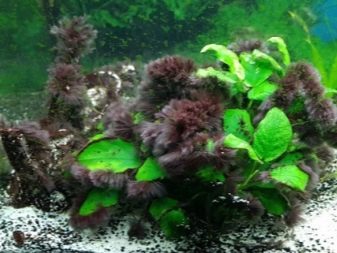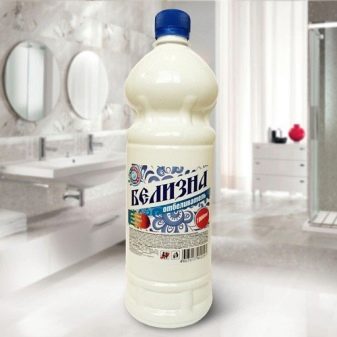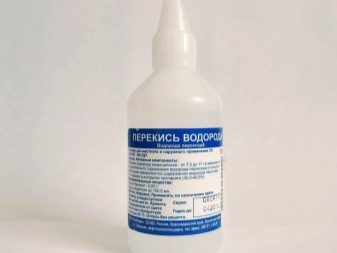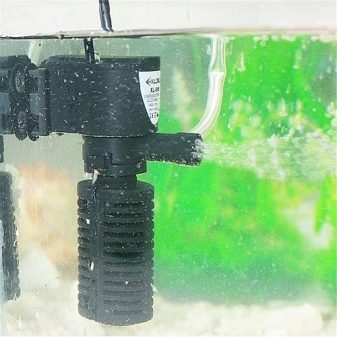The Vietnamese is a real problem that aquarists often encounter. This algae, having appeared in water, fills the whole space as soon as possible, hindering the normal life of aquatic plants. Getting rid of such an unsolicited guest will be quite difficult.


Description of algae
First, let's look at the definitions. Most beginner aquarists believe that algae are any plantings in an aquarium of green or some kind of close color. However, this is not entirely true, only the lower groups of plants that are in swimming or cling to decorative and other surfaces are considered algae. Visually, they resemble moss, threads, bunches or mucus. In total, more than 30,000 species are distinguished.
Flip flops are bunches, the size of the hairs in them does not exceed 2 cm. As a rule, they are placed at the very tips of the leaf plates, as well as on the stems. In addition, it is fashionable to meet algae on grottoes, artificial flora and aquarium decoration elements. The Vietnamese belongs to red algae, although it is more likely brown, brown-gray and even black. This is explained simply: a red pigment is present in its tissues; it is determined only by experience, reacting with alcohol, acetone or another solvent.
It is this pigment that fish farmers consider to be the real root of evil in aquarium farming, since even the most effective algae-eating inhabitants are ineffective, they simply do not eat those plants that contain such a dye.


What hurts a Vietnamese?
Despite the fact that it is impossible to call the Vietnamese a parasite, since it does not feed on plant juices, nevertheless, this algae causes great harm to the aquarium flora. The Vietnamese completely covers the surface of crops growing in the water, thereby blocking the access of light to them, does not pass nutrients to the tissues, and this inevitably leads to the death of plants.
The Vietnamese is rapidly spreading along the inner surface of the tank, it becomes unsightly and ugly - in just a month, all the walls of the aquarium, decor elements and pebbles are covered with a dark coating, which is quite difficult to get rid of.
This variety of algae is distinguished by its exceptional survivability and tenacity, therefore, it is literally “tightly” attached to the place of growth and adheres to it with all its might.

Causes of occurrence
Reproduction in the aquarium flip flops occurs for the following reasons:
- lack of oxygen;
- too strong current;
- overpopulation of the aquarium with fish and invertebrates;
- excessive purging.
First of all, the leaves of the slowest growing plants suffer from red algae, in most cases, an attack of red algae leads to their immediate death. And she also prefers Anubias, Echinodorus and other similar plants with large leaves - usually they also cannot be saved, and the fate of the rest of the plantations can be fought. It is noted that most of the affected reservoirs are illuminated with bulbs with powerful yellow spectrum glow - such radiation creates a favorable environment for the appearance and spread of algae, and has the most adverse effect on the growth of higher vegetation.
Algae grows very quickly under the influence of the sun, so it is important to prevent direct ultraviolet radiation, otherwise, new foci of Vietnamese will arise with great speed, and all that remains for you is to say goodbye to the bushes entirely. As practice shows, most often newly launched artificial reservoirs collide with algae, since they do not have a formed nitrogen cycle.
In addition, beginners usually do not have enough elementary experience in order to deal with misfortune, since effective disposal of the Vietnamese requires a clear understanding of the situation and an instant response. In general, according to experts, the emergence of any type of algae is the most common process, but it is very important to take it under control, only in this case the planted plants will have sufficient strength to take away algae nutrition and cause their growth to stop.


How to get rid?
The fight against flip flops begins with measures of mechanical action on the affected areas - they need to be removed manually as much as possible. In addition, you should remove all stones and decoration elements affected by red algae from the aquarium, they also need to be cleaned with a sponge, and then boiled in water for about half an hour. Usually, after such a treatment, the Vietnamese is completely destroyed, and the jewelry can be used further.
Plants should also be removed from the tank, tear off all infected areas, and then rinse under running water. Keep in mind that you need to remove not only the sheets infected with the Vietnamese, but also all the old or rotten areas, since algae primarily affects weakened parts of plants - it’s important not to give the parasite a single chance for a second attack.
In addition, it will be useful to work with all the remaining elements of the aquarium environment: clean and siphon the sand, treat the thermometers with alcohol, boil all the driftwood, and simply throw out objects made of plastic.
“Whiteness” has good effectiveness, which can be purchased at any hardware store.


The product is diluted with water and left in the resulting solution for 2-3 days. Usually, on the first day, the Vietnamese begins to turn gray, and by the time the treatment is complete, it completely dissolves. Keep in mind, this may change the color of the item, but you simply don’t have any other way to completely clean porous surfaces.
The theme of the fight against the Vietnamese often arises on the forums of aquarists, the brothers in misfortune share with each other how to destroy this algae, but, unfortunately, no one has yet found a panacea.
Borax and boric acid formulations have a short-term effect. - the Vietnamese pauses in growth and it seems that it is about to disappear completely, but as a result it remains to live and multiply, and some higher plants, for example, cryptocoryns, lose their foliage. Moreover, fish under the influence of these drugs lose their appetite and begin to itch on the soil and plant stems.
Copper and silver coins, which have a disinfecting effect, are also powerless. The widely advertised Algumin preparation does not give a result either: on the third day after its use, dark bushes begin to crumble, disappear after a week, but come back again after 3-4 weeks, and with renewed vigor - they grow faster and inhabit the surface of an artificial reservoir much more aggressively .

Has a good effect hydrogen peroxide, but this is a powerful tool, so many weakened plants simply can not withstand its effects and "give up" first. According to experienced aquarists, there is only one drug that really helps to cope with the Vietnamese in the long run - this Sidex. It is able to withstand red algae, but at the same time does not cause the slightest harm to the plants themselves.
During use it does not accumulate in the liquid, but decomposes into water and carbon dioxide during oxidation. Also, the safety of Sidex for fish and other inhabitants of the aquarium fauna has been proven. To treat the tank from algae, 15–20 ml of the composition per 100-liter reservoir is used.
Any medical measures must be accompanied adjustment of water parameters. Helps in the fight against the Vietnamese increase in stiffness up to 8 units - for this, potassium chloride is added to the container at the rate of 2 ml per liter of liquid. In addition, it was found that Vietnamese does not tolerate acidity above the 7.5 pH mark. To create the right environment, it is necessary to use baking soda - 1 g per 5 liters of water. Keep in mind that such changes are detrimental to the state of fish, and therefore any changes in the properties of water should be carried out gradually.
And of course, replacing water helps in the fight against the Vietnamese - in case of aggression, algae should be changed every day 15–20% of the liquid until the enemy is completely eliminated.


Preventive measures
As the saying goes, the disease is easier to prevent than to treat it, and in the case of the Vietnamese, this truth is 100% right. If red algae begins to multiply in your aquarium, the struggle will be long and difficult, and it is unlikely that you will be able to save all the plants. There is no need to hope that it is real to get rid of it forever. Whatever you do, sooner or later it will reappear in your artificial pond. Therefore, special attention should be paid to prevention, which consists in the following:
- it’s important to keep the aquarium population under control;
- you need to monitor the main parameters of the biocenosis, paying particular attention to the balance of nutrients in water and soil;
- take seriously the quality of the compressor and filtering devices;
- from time to time, remove from the tank all the fish that like to dig into the ground and siphon it;
- Do not overfeed your fish - food debris, decomposing, forms favorable conditions for the propagation of red algae.
Any new plants that you plan to place in the aquarium should be carefully examined - for this, plant them in a separate container with water and stir a little. If they are struck by a Vietnamese, then you can see small hairs on the leaves. If you do not trust the verification methods, you can carry out preventative treatment, for this, the whiteness is diluted with water in a ratio of 1 to 20 and the just bought bush is soaked for several minutes, after which the bush is washed and transplanted for permanent residence.
Any methods of dealing with the Vietnamese give only a short-term effect. The only effective way will be the formation of biological equilibrium. As practice shows, creating a healthy microenvironment is not difficult at all - you just need to treat your pets conscientiously and responsibly.


See how to get rid of flip flops in an aquarium without chemistry in the next video.










